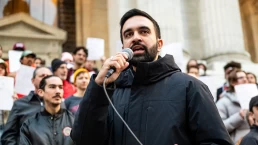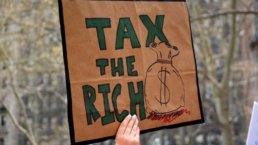Polls recorded shifts in NYC residents’ priorities following mayoral candidate Zohran Mamdani’s campaigning on housing.
By Susan Kang, Truthout
Democrats claim that they are looking for candidates to fix their electoral losses following Donald Trump’s victory. The data shows that Democrats lost ground among young men, urban communities of color, and among voters who cared about affordability issues. Much of the Democratic Party’s leadership is so old that three Democratic Congressional Caucus members died while still in office in 2025, allowing for Trump’s so-called “big, beautiful bill” to pass the House. Currently, in the New York City mayor’s race, the current front-runners are Zohran Mamdani (a 33-year-old democratic socialist State Assemblymember) and Andrew Cuomo (a 67-year-old scandal-plagued former governor pushing fearmongering anti-crime rhetoric that repeats right-wing talking points about New York City). The Democratic leadership class’s consolidation of support for Cuomo, including many who called for his resignation in 2021, shows that they are continuing to pursue the sort of poll-driven, consultant-class strategy that has previously doomed the Democratic Party to defeats.
Following the 2024 general election, pundits and commentators began a circular firing squad to find the problems in the Democratic Party’s electoral strategy. The dominant narrative that seemed to emerge among a set of establishment-aligned Democrats was that Trump won the national election because the party had shifted too far to the left. New York Congressman Ritchie Torres blamed the “far left” and its ivory tower. Mayoral incumbents associated with criminal justice reforms were ousted by moderate challengers in San Francisco and Portland, who claimed that crime and homelessness had ruined cities. Even left-liberal publications like The Nation argued that “blanket progressive appeals to an ideological diverse base” might not be effective to turn out the Democratic base. A February 2025 Gallup survey found that of the Democrats polled, 45 percent wanted the party to become “more moderate” and only 29 percent more liberal; in 2021, only 34 percent wanted the party to become more moderate, while 34 percent wanted the party to become more liberal. The Democratic Party, pundits declared, was out of touch with an increasingly conservative general public, and especially with young people.

Even though there was electoral evidence that the country had not swung fully toward the right, this narrative has held a powerful grip on Democratic strategy. Democratic strategist James Carville suggested that Democrats should let the Trump administration destroy the federal government. “Allow the Republicans to crumble beneath their own weight and make the American people miss us,” Carville wrote in The New York Times in February, calling for the party to not act until Trump’s approval ratings dropped — a move that Carville called a “tactical pause.” Fearful Democratic leadership, such as Senate Minority Leader Chuck Schumer, has largely capitulated to Trump’s demands; Schumer himself supported a spending bill in March to avoid a government shutdown, and then attempted to evade the liberal backlash that followed to protect his own political position. A May article in The New York Times reported that Democratic Party leadership felt lost and confused about the erosion in their historic social and geographic basis of support, as they dealt with a historically low approval rating of 27 percent among registered voters.
But the Democratic Party leadership, especially elected leaders in Congress, continue to flounder and refuse to act as a unified opposition party. Following the June protests against Immigration and Customs Enforcement (ICE) raids in downtown Los Angeles, 75 House Democrats voted with Republicans on a resolution to show gratitude to ICE. Eleven House Democrats later voted to overturn Washington, D.C.’s status as a sanctuary city and demand that D.C. police collaborate with ICE over the wishes of their city council. These moves come despite polling data that shows Democratic voters prefer that the party fight rather than compromise; 65 percent of Democrats want Congress to hold the line against Republicans on key issues, even if it leads to gridlock in D.C. — a reversal from 2017, the first year of Trump’s first term, when 59 percent of Democrats wanted their leadership to compromise with the Trump administration.
Recent Posts
Billionaire’s Mouthpiece Searches For Reasons To Avoid Taxing Billionaires
January 9, 2026
Take Action Now California is considering a referendum on whether to impose a one-time wealth tax on the state’s billionaires.By Jim Naureckas,…
All Democratic Presidential Candidates In 2028 Should Commit To Dismantling ICE
January 8, 2026
Take Action Now Since its inception, ICE has been designed to conflate issues of immigration with terrorist threats against the U.S.By Sam…
Trump Cuts Billions In Federal Childcare Funds For Democratic-Led States After Minnesota Fraud Scandal
January 8, 2026
Take Action Now Administration cites welfare fraud allegations as advocates and state leaders warn of political retaliation and sweeping harm to…
After The ICE Killing In Minneapolis, Will Truth Prevail?
January 8, 2026
Take Action Now Can Trump and Kristi Noem maintain their blatant lies in the face of multiple videos that show the victim was trying to drive away…




